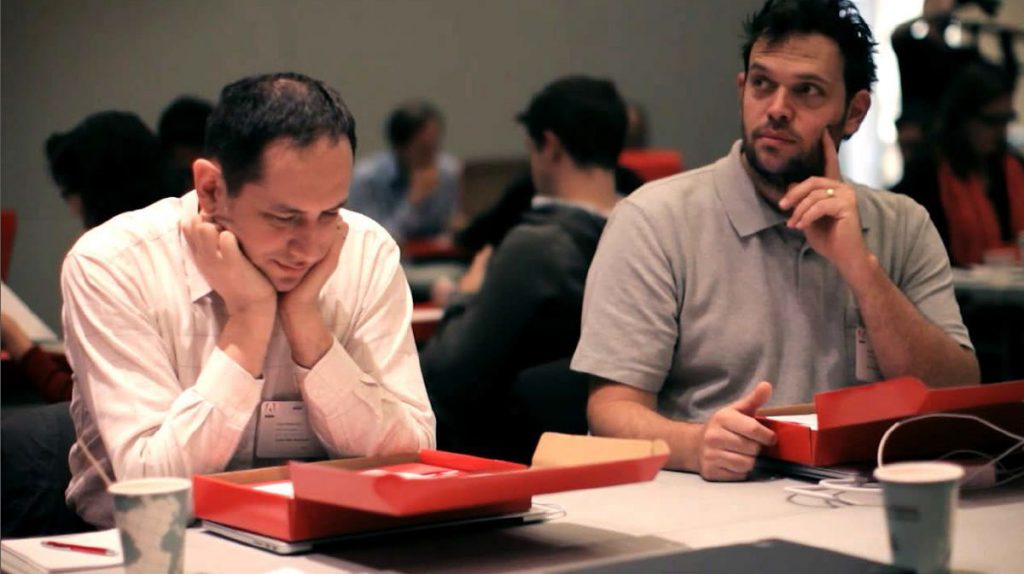Innovation in a Box
Unleashing Entrepreneurship in Your Organisation

Fancy being the CEO of your own company without the bother of management and regulatory red tape?
Just you, maybe a fellow founder, coffee and sweets to sustain and nourish your great idea. And you get to keep your day job.
It almost looks too good to be true but this is the reality at Adobe, which rolled out a little red box chock-full of goodies in its Kickbox. Adobe calls Kickbox an innovation “process for individuals and a system for deploying across an organisationâ€.
Think of Kickbox like a car, and your innovation frameworks or ideation platform as the road – you could drive the car over rough terrain but having a road network means you’re more likely to get to your destination in one piece.
While there was much focus on the $1000 pre-paid credit card in every Kickbox, its transformational value goes far beyond cash. Each Kickbox has instructions including quick-reference cards, action checklists, scorecards, frameworks, exercises and so on to bring ideas to life.
Kickbox empowers even the novice ‘intrapreneur’ (a founder of an internal start-up) with the building blocks to get their idea into flight from the moment they open it.
And just to keep them motivated, Kickbox even comes with a coffee card and sugary goodness!
Adobe has distributed 1000 Kickboxes and this is just the start. By making it available under a Creative Commons license, any organisation can download it as a basis for their internal innovation program.
But this is where turning fantasy into reality is gnarly because Kickbox bumps up against governance, controls and culture in the receiving organisation.
If you’re new to innovation processes or in need of a refresher course, The Strategy Group can help you get on the road quickly using Kickbox and introduce you to supporting frameworks to make the most of the opportunity.
Here are five pointers to help you get started with your first Kickbox:
- Loosen the reigns to speed ideas – Some organisations baulk at handing out $1000 but you shouldn’t. It makes no sense to wrap what is a relatively small amount of money in excessive and expensive controls. Limit governance to the bare minimum to get a lot of packages into the hands of innovators (perhaps restrict to one Kickbox a person a year, if this helps your CFO sleep at night).
- ‘But we don’t have the money’ – Ask yourself, can you afford not to innovate when all around you are? Set a reasonable budget for your innovation program and provide sufficient funds in each Kickbox. If you’re a company of 5000 employees, maybe 250 will take a Kickbox; so at $1000 each that’s just $250,000 for a pay-off that could be worth millions of dollars. That’s money invested well.
- ‘People will steal or fritter away the money’ – If you think this about your employees, why did you hire them? Most are honest and those attracted to this program will be your stars (even if you don’t know it, yet). Empower them and they will pleasantly surprise you.
- Kickbox launches great ideas, fast – Many employees can’t kickstart their ideas because they lack influence or they lack a champion. Even if they do get past the first hurdles, product or service improvement often bogs in bureaucracy. Kickbox cuts red tape to get your organisation innovating straight away.
- Succeed and everyone will know; fail and you fail alone – To encourage people to try risky ideas, allow them to work in private and without publicity. This encourages the broadest spread of intrapreneurs to have a go.
From our experience, the best ideas come from unexpected places, a concept called ‘open innovation’. If you agree, you probably also feel there should be a better way to seed, water and fertilise ideas into bloom. Even failure is OK, because the reward from successful ideas is many times more than the investment.
Programs like Adobe Kickbox put power back in the hands of the innovator, who becomes the CEO of their own idea. It creates a huge amount of buzz and friendly competition in the organisation and may lead to better staff retention and recruitment.
Almost every organisation in Australia can benefit by trying out Kickbox. What are you waiting for?
Image credit: gigazine.net
Wait! Before you go…
Choose how you want the latest innovation content delivered to you:
- Daily — RSS Feed — Email — Twitter — Facebook — Linkedin Today
- Weekly — Email Newsletter —
 Jeffrey Tobias’ career in the application of information technology, strategy and innovation has spanned academia, consulting, big and small business, government, research and entrepreneurship. He is Director of The Strategy Group, delivering strategic advice on Innovation, Design Thinking, Lean Startup, Ideation, Collaboration and Globalisation to corporations and governments, and is an active Angel Investor in the technology space.
Jeffrey Tobias’ career in the application of information technology, strategy and innovation has spanned academia, consulting, big and small business, government, research and entrepreneurship. He is Director of The Strategy Group, delivering strategic advice on Innovation, Design Thinking, Lean Startup, Ideation, Collaboration and Globalisation to corporations and governments, and is an active Angel Investor in the technology space.
NEVER MISS ANOTHER NEWSLETTER!
LATEST BLOGS
The Network Operators are Dead – Long Live the Mobile Operators
There is little doubt now that the telecommunications industry is a tumultous and precarious place to be. On the wireline side, baby bells and cable companies are engaged in a necessary but costly arms race. Both are forced to invest in increasing broadband capacity and coverage while simultaneously facing increasing competition from wireless service providers.
Read MoreInvention versus Innovation – Auto Industry Example
Here is an invention that never became an innovation (for sale on eBay): Want to buy a car with disappearing doors? (check out the video) Up next week – “Invention versus Innovation” How do you think invention and innovation are different? I’ll give you my point of view next week.
Read More



